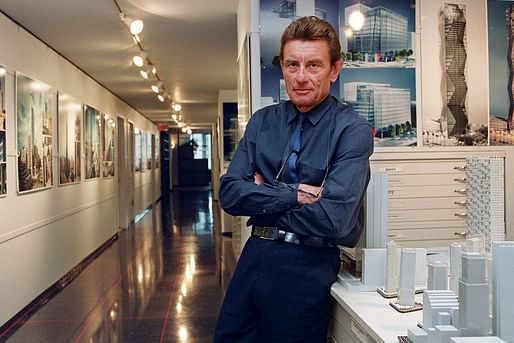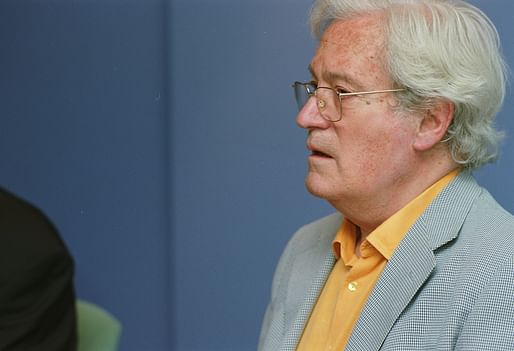
2021 was unfortunately a record year in terms of the death notices and obituaries of many who contributed to our profession in ways both large and small.
Our pages were filled with heartfelt tributes to the many who were taken from us in fields that included academia (like Thomas Gordon Smith, Lance Hosey, and Donald P. Ryder) and urban planning (Alexander Garvin and Niall McCullough) as well as a multitude whose contributions to modernism (Bernard Judge, James L. Nagle, and Hugh Newell Jacobson) and other forms of architecture (Alan Lapidus) will be tragically missed, and still more whose work in preservation (Charles Cassell), conceptual art (Lawrence Weiner), architecture journalism (Kristen Richards), and philanthropy (Eli Broad and Richard Driehaus) will be remembered with equal fondness.
Here below is a list of select names we lost in the past year.
Richard Rogers (1933–2021)
More than a colorful character, Rogers was the progenitor of the high-tech style as well as a key contributor to the modernist movement which helped change the image of cities like London and Paris. His inside-out designs were a refreshing update to designers like Richard Neutra and Rudolph Schindler, leaving a mark through more than 400 distinctive creations which ranged from lesser-known residential projects in Cornwall to the European Court of Human Rights building in Strasbourg, and finally to the remarkable design for insurance giant Lloyd’s headquarters in London, for which he won the Pritzker Prize.
Virgil Abloh (1980–2021)
Trained as an engineer and architect, Abloh utilized his academic background to engender a host of iconic creations. An inspirational figure to a generation of young designers, Abloh’s work was defined by collaborations with brands like Nike, and the eventual success of his own label Off-White. His untimely death came as a shock to the design and fashion communities, the latter having recently paid tribute with a fitting send-off in Miami just a few short days after his passing.

Helmut Jahn (1940–2021)
In May, the architectural community was saddened to learn of Jahn’s passing in a tragic bicycling accident just outside of Chicago. Jahn was a domineering figure in architecture in that city, dotting its skyline with supertalls and spearheading the creation of one its most iconic landmarks, the state-owned landmark James R. Thompson Center, the destruction of which his death appears to have forestalled.
Stephen B. Jacobs (1939–2021)
Jacobs was a Holocaust survivor who left his mark on New York City in more ways than one, pioneering methods in adaptive reuse and creating new residential spaces across the city and in Connecticut. Jacobs eventually turned to real estate development as a result of his proximity to the industry and was instrumental to the transformation of various neighborhoods such as Clinton Hill and Fort Greene.

Chris Wilkinson (1945–2021)
The two-time Stirling Prize winner was truly a giant of the industry in league with his countrymen Richard Rogers and Norman Foster. His designs included standouts like the 2010 Earth Sciences building at Oxford and One Barangaroo Tower in Sydney. He was instrumental in bridging out to form award-winning collaborations with inventor James Dyson and fellow architect Jim Eyre, with whom he established the eponymous firm WilkinsonEyre in 1999.
Art Gensler (1935–2021)
Despite his friendly everyman demeanor, Gensler was one the most successful architects and entrepreneurs of the past 50 years, turning what was at first a small office in his adopted home of San Francisco into one of the largest architectural firms in the world. Gensler’s oversight and business acumen eventually led to an extensive portfolio of corporate projects that spilled over into broader areas that included hospitality and transportation design. He was a mainstay in our editorial coverage and will live on as an inspiration to many a young architect forced to get by on optimism and imagination alone.
Terence Riley (1954–2021)
The bespectacled Riley was a formidable figure in the world of letters and architecture. The critic and former MoMA chief curator left behind a legacy of superlative exhibitions and a host of titles on subjects ranging from Frank Lloyd Wright to the architecture of transparency. His tenure as the director of Miami’s since-renamed Perez Art Museum may have ended abruptly, but his name will live on as perhaps the most influential design curator of his generation, a title that overshadows his own work as the founder of Keenan/Riley, through which he was responsible for creating the reimagined the Sarasota Art Museum in 2019.
Paulo Mendes da Rocha (1928–2021)
Mendes da Rocha’s designs are synonymous with his native Brazil and the brutalist subspecies that flowed therefrom. He was aligned with the influential Paulista School group early on and continued to a solo career which included seminal works such as the Patriarch Plaza and Pritzker-winning Saint Peter Chapel in São Paulo. A longtime lecturer at the University of São Paulo, Mendes da Rocha was remembered as a “generous educator” whose death left the architectural world “immediately poorer” according to a statement from the Casa de Arquitectura in May.

Oriol Bohigas (1925–2021)
Bohigas spent his life in pursuit of anti-Francoist architecture and as an inventive urbanist who left a mark on his native Barcelona through his work on the 1992 Olympic planning committee. The former president of the Joan Miro Foundation, Bohigas was aligned with leftist social movements such as the Catalan Socialist Party and Gauche Divine. He will live on through the memory of projects such as the Expo ‘92 pavilion and Design Museum of Barcelona as well as the reorganization of much of the city’s beaches and coastline, for which the Catalonian President Pere Aragonès called him a “great transformer.”
Gottfried Böhm (1920–2021)
The third Pritzker Prize winner on this list, Böhm was known as a master of concrete and became synonymous with church architecture, with seminal projects in the towns of Neviges and Alfter, perfect supplements to civic buildings for Cologne and Ulm, which in turn were supplementary of cultural projects like the Stuttgart Opera House and Hans Otto Theater. His legacy is passed down through the work of his son Paul, with whom he designed the Cologne Central Mosque in 2017.
Owen Luder (1928–2021)
Known as a champion of Brutalism, Luder served as RIBA President a record two terms and professionally paired with architect Rodney Gordon to realize a number of cultural and multi-use developments which ultimately failed to withstand tests of time and criticism. Luder’s erstwhile “Dunston Rocket” housing complex was an excellent example of the ways in which Brutalism’s bad rap can lead to permanent erasure. Recently, a shopping mall created in 1974 became the cat-alyst of a cat-themed regeneration project from Tsuruta Architects.
Nathan Johnson (1925–2021)
Last but certainly not least, Johnson was an influential designer of modernist church architecture hailing from the Detroit area. He had a distinctive style and similar distaste for decorative elements and symbolism. Johnson initially worked out of his basement while establishing his reputation throughout the city as a preeminent civic design leader, eventually earning larger commissions through his appointment as the Board of Education's first Black architect. The fact that it took three weeks for his obituary to be picked up by a national outlet like The New York Times is itself a statement on the challenges of representation that other architects of color still face today.
No Comments
Block this user
Are you sure you want to block this user and hide all related comments throughout the site?
Archinect
This is your first comment on Archinect. Your comment will be visible once approved.